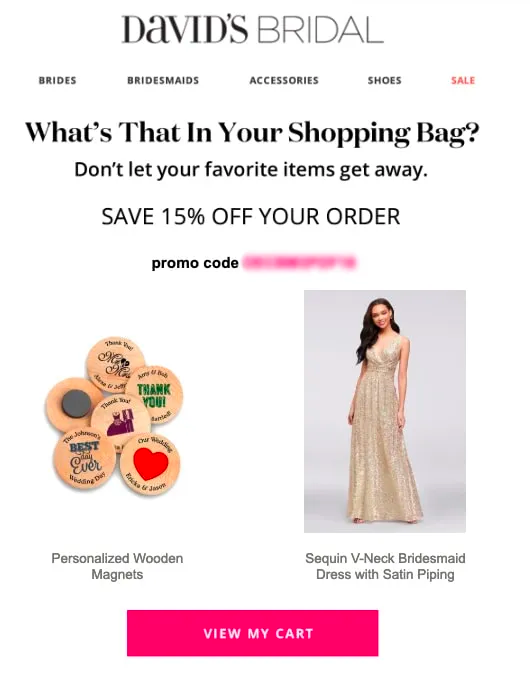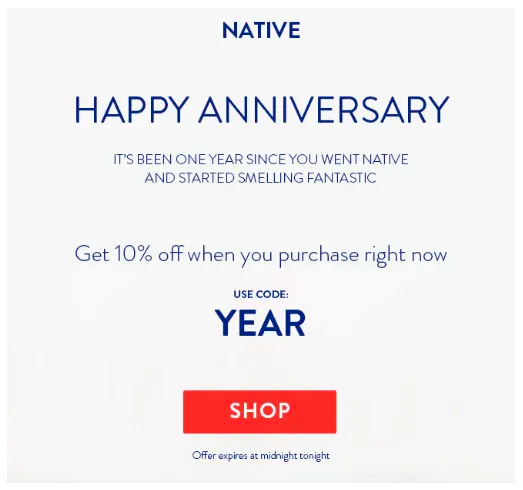Marketers know that first impressions are everything, especially when it comes to ecommerce. Although positive early interactions with customers are important, the interactions following that initial contact are just as critical.
It’s those repeated interactions that build brand loyalty, encourage repeat purchases, and create long-term relationships with customers. Laying a solid foundation from the beginning can increase your customer retention, and help position your brand as one that takes care of customers.
But how do you make sure you’re reaching your customers at the right time? What’s an optimal way to engage with customers that will yield the best ROI?
An email marketing strategy is a powerful way to build those long-term relationships with customers and boost your customer retention. In fact, a study from McKinsey & Company found that the emails prompt purchases at a rate that is at least three times higher than social media.
Of course, it’s important to engage with your customers through multiple channels, but creating a bulletproof, results-oriented email marketing strategy should be high on your priority list.
How an Email Marketing Strategy Boosts Customer Retention
Let’s first examine what makes an email marketing strategy so effective.
- Email helps keep you top-of-mind: Sending your customers regular emails that have intention and value keeps you fresh in their minds.
- It’s cost-effective: When executed properly, email is a highly effective, cost-efficient element of a larger marketing strategy. According to DMA, a UK-based marketing research association, marketers can expect to make $43 for every $1 they spend on email marketing. That adds up quickly.
- Connect with customers in a better way: Email marketing allows you to connect with customers on a level of the customer journey that you may not get with other channels. After all, who doesn’t like opening up emails with discount codes, or receiving early access to sales from one of their favorite brands?
In short, strategy works.
So what does this look like in practice? Let’s take a look at a few email marketing strategies that will help your retention rate and build those valuable long-term customer relationships.
Personalization
You’ve likely read about the dreaded email marketing flubs of misused personalization that seem to happen all too often. Misspelled names, formatting errors, or perhaps the worst of all — forgetting to fill in the “name” field, resulting in something like this:
Hey, {First_Name}! Thanks for your purchase.
No company wants to be that company. Go beyond simple first name personalization.
For example, product recommendations based on customer shopping behavior, links to relevant articles on your blog, content specific to different geographic locations, and even customized cart abandonment emails can help set your brand apart.

This cart abandonment email from David’s Bridal serves as a nudge for customers to return to their cart. It also encourages them to buy right away by offering 15% off their purchase.
Provide Value in Every Email
An excellent way to instantly stand out in the sea of emails that flood your customers’ inboxes is to give them something of value in every email you send. From discount codes and pre-sale access to product updates and relevant blog posts, always provide your customers with something they want.
If you give your customers something of value, it’s likely they’ll share it with their followers and friends. Some companies find that their email subscribers are three times more likely to share content via social media than website visitors from other sources. Every email is a valuable opportunity to drive social sharing. So if your email doesn’t provide something that is going to either help build your relationship with your customers or encourage them to convert, rethink your strategy.
Choose Your Send Date and Time Wisely
The best time to send an email is unique to your customers and their behavior.
Sure, there are definitely some better times to send an email than others, but making that decision based on your customers’ behavior is the “golden ticket.”
Run a split test on a few campaigns and see if you can identify any patterns in open rates that correlate with the time of day and day of the week. Testing and seeing firsthand when your customers are opening your emails is the only true way to determine what will work best.
Make Sure Emails Are Mobile-Responsive
This seems like a no-brainer, but if your email isn’t suited for mobile devices, consider it moved to the trash folder. Mobile devices account for about 46% of all email opens, followed by webmail opens at 35%, and desktop opens at 18%.
Most email marketing platforms allow you to preview your email on different devices, so work out any formatting kinks before you hit send.
A/B Test Subject Lines (and Everything Else While You’re at It)
A/B testing, also known as split testing, is an integral part of any email marketing strategy. As we mentioned above, it’s important to A/B test different variables of your email so you can optimize to the fullest.
Examples of variables to A/B test include:
- Subject lines
- Copy and headlines
- CTAs (call-to-action)
- Imagery
- Email send time and day of the week
- Offers
- Personalization elements
- Format and layout
A/B testing should be done regularly to ensure you’re making the best decisions regarding your campaigns, and your customers see variables that will move them toward converting.
Be Strategic With Your CTAs
It’s essential for every email to include a call-to-action (CTA) that tells customers what they should do next. According to Campaign Monitor, using a CTA button instead of a text link can increase conversion rates by as much as 28%.
Optimizing your CTAs — whether it’s by design, copy, color, size, or placement — can help boost your conversion rates, which plays a significant role in customer retention. A great way to understand the impact of your CTA placement is by split testing.
Keep these tips in mind when designing and testing your CTAs:
- Make your CTA stand out, whether that be with size, color, or placement in the email
- Include action-driving copy (e.g., “Create your unique shampoo” or “Build your kit”)
- Keep it short but clear
- Create a sense of urgency
- Use eye-catching colors
Be intentional with your CTAs to ensure clarity and follow-through.
Segment Your Subscribers
Segmentation is a powerful email marketing strategy that makes it easier than ever to ensure your customers are seeing the right content, landing pages, and products. According to DMA, 76% of email ROI comes from segmented and triggered emails.
Every customer has their unique interests, budget, and shopping habits, so reaching them at just the right time can help you increase conversions and customer retention.
Segmenting your customers gives you the opportunity to send specific discounts easily, thank customers for their purchases, and reward them. Also, that layer of customization can help you stay out of your customers’ spam folders.
Surprise and Delight Your Customers
Who doesn’t love getting discount codes or freebies delivered to their inbox on their birthday or just because? Sending customers promotions they may not be anticipating or that aren’t the usual sale announcements shows customers that you care.
For example, Native, a deodorant manufacturer, sent the following email to everyone who had been on their email list for a year.

Instead of a routine Thanks for being a Native customer, they emphasize the added value of a discount to email list members.
This initiative from Native not only surprises the customers and encourages them to make a purchase, but it also adds a layer of personalization.
Leverage Reviews and Collect More Customer Data
It’s no secret that testimonials and product reviews are essential to your business, but obtaining them can be tedious and not always successful — especially if you ask customers too long after they’ve made their purchase.
Amazon is the king of product reviews and recommendations, and it’s a significant component that fuels their business. This follow-up email is a great example.

The email clearly shows the recently purchased item and makes it easy to rate the product. There’s even a call-to-action at the bottom that nudges the customer to review other purchased products.
Collecting testimonials and reviews can be a daunting process, but thanks to automation, you can easily collect the data about your customers that will help you personalize your marketing efforts in the future.
Know Your Customers
Strategic, intentional email marketing strategy that caters to your customers based on their unique behaviors and demographics can make a significant impact on customer retention.
Leverage the data you have, and work on collecting more that you can use to enhance your customer experience.
Managed WooCommerce Hosting Can Help
With Nexcess managed WooCommerce hosting platform, you can expect a reduction in query loads up to 95%. The platform comes standard with cart abandonment technology from robust security and more.
Check out our plans to get started today.

